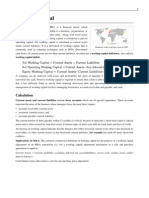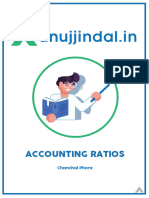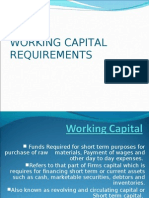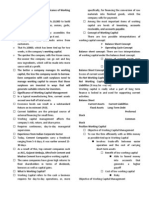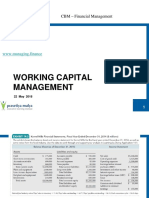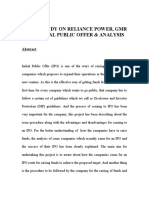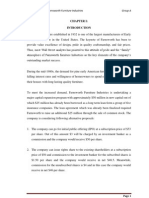CH 11 PPTs
CH 11 PPTs
Uploaded by
hariyadi030267313Copyright:
Available Formats
CH 11 PPTs
CH 11 PPTs
Uploaded by
hariyadi030267313Original Title
Copyright
Available Formats
Share this document
Did you find this document useful?
Is this content inappropriate?
Copyright:
Available Formats
CH 11 PPTs
CH 11 PPTs
Uploaded by
hariyadi030267313Copyright:
Available Formats
11
CHAPTER
Credit Analysis
Company Liquidity refers to the ability to meet short-
term obligations
Liquidity is the ability to convert
assets into cash or to
obtain cash
Short term is the longer of one-year
or the company operating cycle
Liquidity and Working Capital
Basics
Liquidity is a matter of degree
Lack of liquidity can limit
Advantages of favorable discounts
Profitable opportunities
Management actions
Coverage of current obligations
Liquidity and Working Capital
Basics
Severe illiquidity often precedes
Lower profitability
Restricted opportunities
Loss of owner control
Loss of capital investment
Insolvency and bankruptcy
Liquidity and Working Capital
Basics
Current assets are cash and other assets reasonably expected to be
(1) realized in cash, or (2) sold or consumed, during the longer of one-
year or the companys operating cycle
Current assets include:
Cash -- ultimate liquid asset
Cash equivalents -- temporary investments of excess cash
Marketable securities -- debt or equity securities held as s-t investments
Accounts receivable -- mounts due from credit sales
Inventories -- items held for sale in the normal course of business
Prepaid expenses -- advance payments for services and supplies
Liquidity and Working Capital
Current Assets
Classification as current asset
depends on:
1. Manaments intent
2. Industry practice
Analysis must assess this classification
1. Is classification as current asset appropriate?
2. If not, then adjust accounts and amounts among current
and noncurrent
Liquidity and Working Capital
Current Assets
Balance
Sheet
Classification as current liability depends on:
1. Manaments intent
2. Industry practice
Analysis must assess this classification
1. Is classification as current liability appropriate?
2. If not, then adjust accounts and amounts among current and noncurrent
3. Are current liabilities reported?
4. If not, then adjust accounts for these amountspotential examples:
Contingent liabilities associated with loan guarantees
Future minimum rental payments under noncancelable operating leases
Progress payments under contracts
Current deferred tax liabilities (and assets)
Liquidity and Working Capital
Current Liabilities
Working capital is
defined as the excess of current assets over current liabilities
Widely used measure of short-term liquidity
Deficient when current liabilities exceed current assets
In surplus when current assets exceed current liabilities
A margin of safety for creditors
A liquid reserve to meet contingencies and uncertainties
A constraint for technical default in many debt agreements
Liquidity and Working Capital
Working Capital
Working capital more relevant when related to other key
variables such as
Sales
Total assets
Working capital is of limited value as an absolute
amount
Liquidity and Working Capital
Working Capital
Current Ratio Reflects on:
Current liability coverage -- assurance in covering current
liabilities
Buffer against losses -- margin of safety for shrinkage in
noncash current assets
Reserve of liquid funds --margin of safety
against uncertainties and shocks to cash flows
Liquidity and Working Capital
Current Ratio
s liabilitie Current
assets Current
= ratio Current
Current Ratio Limitations:
If liquidity is the ability to meet cash outflows with adequate
cash inflows, then does the current ratio:
Measure and predict the pattern of future cash inflows and
outflows?
Measure the adequacy of future cash inflows to outflows?
Answer is generally no to both these questions
Current ratio
Is a static measure
Does not have a causal relation to future
cash inflows
Liquidity and Working Capital
Current Ratio
Current Ratio Limitations in Numerator
Adjustments often needed to counter various limitations such as
Failure to reflect open lines of credit
Adjust securities valuation since the balance sheet date
Reflect revolving nature of accounts receivable
Recognize profit margin in inventory
Adjust inventory values to market
Remove deferred charges of dubious liquidity from
prepaid expenses
Liquidity and Working Capital
Current Ratio
Three important qualifications
1. Liquidity depends to a large extent on prospective cash
flows
2. No direct relation between working capital account
balances and patterns of future cash flows
3. Managerial policies are directed primarily at efficient and
profitable asset utilization and secondly at liquidity
4. Cash flow forecasts and pro forma financial statements
are preferred over the current ratio for liquidity and
solvency analysis
5. Current ratio is a static measure of the ability of current
assets to satisfy current liabilities
Liquidity and Working Capital
Current Ratio
Two important elements are integral to use of the current
ratio
1. Quality of both current assets and current liabilities
2. Turnover rate of both current assets and current
liabilities
Liquidity and Working Capital
Current Ratio
Comparative Analysis
Two useful tools in analyzing
the trend in the current ratio
Trend analysis -- components of working capital and the
current ratio are converted to indexes and examined over
time
Common-size analysis -- composition of current assets is
examined over time
Liquidity and Working Capital
Current Ratio - Applications
Ratio Management (window dressing)
Examples are:
Press the collection of
receivables at year-end
Call in advances to officers for
temporary repayment
Reduce inventory below normal
levels
Delay normal purchases
Proceeds from these activities are then
used to pay off current liabilities
Liquidity and Working Capital
Current Ratio - Applications
Rule of Thumb Analysis (2:1)
> 2:1 superior coverage of current liabilities (but not
too high, suggesting inefficient use of resources
and reduced returns)
< 2:1 deficient coverage of current liabilities
Liquidity and Working Capital
Current Ratio - Applications
Net Trade Cycle Analysis
Working capital requirements are affected by its desired
inventory investment and the relation between credit
terms from suppliers and those extended to customers
Liquidity and Working Capital
Current Ratio - Applications
Net Trade CycleIllustration
Selected financial information from Technology Resources, Inc., for the end of Year 1 is
reproduced below:
Sales for Year 1 $360,000
Receivables 40,000
Inventories* 50,000
Accounts payable 20,000
Cost of goods sold
(including depreciation of $30,000) 320,000
*Beginning inventory is $100,000.
We assume these relate to purchases included in cost of goods sold.
We estimate Technology Resources purchases per day as:
Purchases per day = $240,000 360 = $666.67
The net trade cycle for Technology Resources is computed as (in days):
Liquidity and Working Capital
day s 66.24 = (day s) cy cle trade Net
day s 30.00 =
$666.67
$20,000
= pay able Accounts : Less
day s 96.24
day s 56.24 =
360 $320,000
$50,000
= s Inv entorie
day s 40.00 =
360 $360,000
$40,000
= receiv able Accounts
Current Ratio - Applications
Sales Trend Analysis
Trend analysis review of sales trend across time
Liquidity and Working Capital
Current Ratio - Applications
Cash to Current Assets Ratio
Larger the ratio, the more liquid are current assets
Liquidity and Working Capital
Cash-Based Ratio of Liquidity
assets Current
securities Marketable + s equivalent Cash + Cash
Cash to Current Liabilities Ratio
Larger the ratio, the more cash available to pay current
obligations
Liquidity and Working Capital
s liabilitie Current
securities Marketable + s equivalent Cash + Cash
Cash-Based Ratio of Liquidity
Accounts Receivable Turnover
Operating Activity Analysis of Liquidity
Accounts Receivable Liquidity
receivable accounts Average
credit on sales Net
Operating Activity Analysis of Liquidity
Accounts Receivable Liquidity
Receivables Turnover for Selected Industries
0 20 40 60 80 100 120 140
Food stores
Eating and drinking
Motion pictures
Printing and publishing
Electrical equipment
Educational services
General merchandise
Receivables turnover
Source: Dun & Bradstreet
Accounts Receivable Collection Period
Operating Activity Analysis of Liquidity
Accounts Receivable Liquidity
turnover receivable Accounts
360
= period Collection
Days Sales in Receivables (Alternative to Collection Period)
Operating Activity Analysis of Liquidity
Accounts Receivable Liquidity
360
Sales
Receivable Account
Temporal Trend Analysis
Trend in:
1. Collection period over time
2.
Operating Activity Analysis of Liquidity
Accounts Receivable Liquidity
receivable accounts Gross
accounts doubtful for Provision
Inventory Turnover
Measures the average rate of speed inventories move
through and out of a company
Operating Activity Analysis of Liquidity
Inventory Turnover
inventory Average
sold goods of Cost
Days to Sell Inventory
Useful in assessing purchasing and production policiesshows the number of
days a company takes in selling average inventory for that year
Alternative computation-- Days Sales in Inventory
where the cost of average days sales is:
Shows the number of days required to sell ending inventory
Operating Activity Analysis of Liquidity
Inventory Turnover
turnover Inventory
360
sales s day' average of Cost
inventory Ending
360
sold goods of Cost
Selected financial information from Macon Resources, Inc., for the end of
Year 8 is reproduced below:
Sales $1,800,000
Cost of goods sold 1,200,000
Beginning inventory 200,000
Ending inventory 400,000
Inventory turnover ratios using average inventory are computed as:
Inventory turnover ratios based on ending inventory equal:
Operating Activity Analysis of Liquidity
Inventory Turnover - Illustration
days Days
Inventory
90
4
2 ) 000 , 400 $ 000 , 200 ($
=
=
+
4
360
= rati o i nventory sel l to
$1,200,000
= rati o turnover
days
$3,333
$400,000
= i nventory i n sal es Days'
$1,200,000
= sal es s day' average of Cost
120
333 , 3 $
360
=
=
Conversion Period (Operating Cycle):
Days to Sell Inventory + Collection Period
Measure of the speed with which inventory is converted
to cash
Operating Activity Analysis of Liquidity
Inventory Turnover
Quality of Current Liabilities
Must be judged on their degree of urgency in
payment
Must be aware of unrecorded liabilities having a claim
on current funds
Operating Activity Analysis of Liquidity
Liquidity of Current Liabilities
Days Purchases in Accounts Payable
Measures the extent accounts payable represent current
and not overdue obligations
Operating Activity Analysis of Liquidity
Inventory Turnover
360 Purchases
payable Accounts
= payable accounts in purchases Days
Additional Liquidity Measures
Asset Composition
Composition of current
assets is an indicator of
working capital liquidity
Use of common-size
percentage comparisons
facilitates this analysis
Balance
Sheet
Acid-Test (Quick) Ratio
s liabilitie Current
receivable Accounts + securities Marketable + s equivalent Cash + Cash
Is a more stringent test of liquidity
vis--vis current ratio
Additional Liquidity Measures
Dun & Bradstreet's Quick Ratio for Selected
Industries
0 0.3 0.6 0.9 1.2 1.5
Food stores
Eating and drinking
Motion pictures
Printing and publishing
Electrical equipment
Educational services
General merchandise
Ratio
Acid-Test (Quick) Ratio
Additional Liquidity Measures
Source: Dun & Bradstreet
(Cash + Account Receivables/Current Liabilities)
Cash Flow Measures
Cash Flow Ratio
A ratio of 0.40 or higher is common for
healthy companies
s liabilitie Current
flow cash Operating
Additional Liquidity Measures
Financial Flexibility
Financial flexibility - ability of a company to take steps
to counter unexpected interruptions in the flow of funds
Focus of analysis:
Ability to borrow from various
sources
To raise equity capital
To sell and redeploy assets
To adjust the level and direction of
operations to meet changing
circumstances
Levels of prearranged financing and
open lines of credit
Additional Liquidity Measures
Managements Discussion and Analysis
MD&A requires a discussion of liquidity including
Known trends
Demands
Commitments
Uncertainties
Ability to generate cash
Internal and external sources of liquidity
Any material unused sources of liquid assets
Additional Liquidity Measures
Additional Liquidity Measures
What-If Analysis
What-if analysis -- technique to trace through the
effects of changes in conditions or policies on the
cash resources of a company
What-If Analysis - Illustration
Background DataConsolidated Technologies at December 31, Year 1:
Cash $ 70,000
Accounts receivable 150,000
Inventory 65,000
Accounts payable 130,000
Notes payable 35,000
Accrued taxes 18,000
Fixed assets 200,000
Accumulated depreciation 43,000
Capital stock 200,000
The following additional information is reported for Year 1:
Sales $750,000
Cost of sales 520,000
Purchases 350,000
Depreciation 25,000
Net income 20,000
- Anticipates 10 percent growth in sales for Year 2
- All revenue and expense items are expected to increase by 10 percent, except for
depreciation, which remains the same
- All expenses are paid in cash as they are incurred
- Year 2 ending inventory is projected at $150,000
- By the end of Year 2, predicts notes payable of $50,000 and a zero balance in accrued taxes
- Maintains a minimum cash balance of $50,000
Additional Liquidity Measures
What-If Analysis - Illustration
Case 1: Consolidated Technologies is considering a change in credit policy where ending accounts
receivable reflect 90 days of sales. What impact does this change have on the companys cash balance?
Will this change affect the companys need to borrow?
Our analysis of this what-if situation is as follows:
Cash, January 1, Year 2 $ 70,000
Cash collections:
Accounts receivable, January 1, Year 2 $ 150,000
Sales 825,000
Total potential cash collections $ 975,000
Less: Accounts receivable, December 31, Year 2 ( 206,250)(a) 768,750
Total cash available $ 838,750
Cash disbursements:
Accounts payable, January 1, Year 2 $ 130,000
Purchases 657,000(b)
Total potential cash disbursements $ 787,000
Accounts payable, December 31, Year 2 ( 244,000)(c) $ 543,000
Notes payable, January 1, Year 2 $ 35,000
Notes payable, December 31, Year 2 ( 50,000) (15,000)
Accrued taxes 18,000
Cash expenses(d) 203,500 749,500
Cash, December 31, Year 2 $ 89,250
Cash balance desired 50,000
Cash excess $ 39,250
Explanations:
(a)
(b)Year 2 cost of sales*: $520,000 1.1 = $ 572,000
Ending inventory (given) 150,000
Goods available for sale $ 722,000
Beginning inventory ( 65,000)
Purchases $ 657,000
* Excluding depreciation.
(c)
(d) Gross profit ($825,000 $572,000) $ 253,000
Less: Net income $ 24,500*
Depreciation 25,000 ( 49,500)
Other cash expenses $ 203,500
*110 percent of $20,000 (Year 1 N.I.) + 10 percent of $ 25,000 (Year 1 depreciation).
Additional Liquidity Measures
Solvency -- long-run financial viability and
its ability to cover long-term obligations
Capital structure -- financing sources
and their attributes
Earning power recurring ability to
generate cash from operations
Loan covenants protection against insolvency and
financial distress; they define default (and the legal
remedies available when it occurs) to allow the
opportunity to collect on a loan before severe distress
Basic of Solvency
Facts
Equity financing
Risk capital of a company
Uncertain and unspecified return
Lack of any repayment pattern
Contributes to a companys stability and solvency
Debt financing
Must be repaid with interest
Specified repayment pattern
When the proportion of debt financing is higher, the higher
are the resulting fixed charges and repayment commitments
Basic of Solvency
Capital Structure
From a shareholders perspective, debt financing is less
expensive than equity financing because:
1.Financial Leverage--Interest on most
debt is fixed, and provided interest is
less than the return earned from debt
financing, the excess return goes to
equity investors
2.Tax Deductibility of Interest--Interest is
a tax-deductible expense whereas
dividends are not
Basic of Solvency
Motivation for Debt
Leverage -- use of debt to increase net income
Leverage:
Magnifies both managerial success (profits) and failure
(losses)
Increases risks
Limits flexibility in pursuing opportunities
Decreases creditors protection against loss
Companies with leverage are said to be trading on the equity
omplying a company is using equity financing to obtain debt
financing in a desire to reap returns above the cost of debt.
Basic of Solvency
Financial Leverage
Trading on the EquityReturns for Different Earnings Levels ($ thousands)
Financing Sources Return on
Income before
Interest and 10 Percent Net Net Income + [Interest
Assets Debt Equity Taxes Debt Interest Taxes* Income (1 - Tax Rate)] Assets Equity
Year 1:
Risky, Inc. $1,000,000 $400,000 $600,000 $200,000 $40,000 $64,000 $96,000 $120,000 12.0% 16.0%
Safety, Inc. 1,000,000 1,000,000 200,000 80,000 120,000 120,000 12.0 12.0
Year 2:
Risky, Inc. 1,000,000 400,000 600,000 100,000 40,000 24,000 36,000 60,000 6.0 6.0
Safety, Inc. 1,000,000 1,000,000 100,000 40,000 60,000 60,000 6.0 6.0
Year 3:
Risky, Inc. 1,000,000 400,000 600,000 50,000 40,000 4,000 6,000 30,000 3.0 1.0
Safety, Inc. 1,000,000 1,000,000 50,000 20,000 30,000 30,000 3.0 3.0
* Tax rate is 40 percent.
Return on assets = Net income + Interest (1 0.40)/Assets.
Return on equity = Net income/Shareholders equity.
Basic of Solvency
Financial Leverage - Illustration
Consider two companies results for Year 2:
Year 2 Financials Risky, Inc. Safety, Inc.
Income before interest and taxes $ 100,000 $ 100,000
Interest (10% of $400,000) 40,000
Income before taxes $ 60,000 $ 100,000
Taxes (40%) 24,000 40,000
Net income $ 36,000 $ 60,000
Add back interest paid to bondholder 40,000
Total return to security holders
(debt and equity) $ 76,000 60,000
Basic of Solvency
Financial Leverage- Illustrating Tax Deductibility
of Interest
Financial Leverage Ratio
Greater the proportion of financing from equity vs. debt
lower the financial leverage ratio
Note: Financial leverage ratio is a component
of the disaggregated return on equity
see Chapter 8
Basic of Solvency
Financial Leverage
capital equity Common
assets Total
Potential accounts needing adjustments Chapter reference
Deferred Income Taxes Is it a liability, 3 & 6
equity, or some of both?
Operating Leases -- capitalize non- 3
cancelable operating leases?
Off-Balance-Sheet Financing 3
Pensions and Postretirement Benefits 3
Unconsolidated Subsidiaries 5
Contingent Liabilities 3 & 6
Minority Interests 5
Convertible Debt 3
Preferred Stock 3
Basic of Solvency
Adjustments for Capital Structure - Liabilities
Balance
Sheet
Potential accounts needing adjustments Chapter reference
InventoriesLIFO Reserve? 4
Marketable Securities 4
Intangible Assets 4 & 5
Basic of Solvency
Adjustments for Capital Structure - Assets
Balance
Sheet
Projection of Future Cash Inflows and Outflows
Reflects on risk for a levered companys capital structure
Prepare a Statement of Forecasts of Cash Inflows and
Outflows
Capital Structure and Solvency
Long-Term Projections
Chapter 10 described and illustrated long-term cash flow forecasts
Capital structure composition analysis
Performed by constructing a common -
size statement of liabilities and equity
Reveals relative magnitude of financing sources
Allows direct comparisons across different
companies
Two Variations(1) Use ratios, and (2) Exclude current
liabilities
Capital Structure and Solvency
Common-Size Statements
Total Debt to Total Capital (also called total debt ratio)
Capital Structure and Solvency
Capital Structure Measures
capital Total
debt Total
Capital Structure and Solvency
Capital Structure Measures
Long-Term Debt to Equity Ratio
0.0 0.1 0.2 0.3 0.4 0.5
Food stores
Eating and drinking
Motion pictures
Printing and publishing
Electrical equipment
Educational services
General merchandise
Ratio
Source: Dun & Bradstreet
Total Debt to Equity Capital
Reciprocal measure of this ratioEquity Capital to
Total Debt
Capital Structure and Solvency
Capital Structure Measures
equity s hareholder S
debt Total
debt Total
equity s hareholder S
Long -Term Debt to Equity Capital (also called
Debt to Equity)
Capital Structure and Solvency
equity s hareholder S
debt term - Long
Capital Structure Measures
Capital Structure and Solvency
Capital Structure Measures
Total Debt to Equity
0.0 0.2 0.4 0.6 0.8 1.0
Food stores
Eating and drinking
Motion pictures
Printing and publishing
Electrical equipment
Educational services
General merchandise
Ratio Source: Dun & Bradstreet
Short-Term Debt to Total Debt
Equity Capital at Market Value
Capital Structure and Solvency
Capital Structure Measures
Common-size and ratio analyses of capital structure mainly reflect
capital structure risk
Capital structure measures serve as screening devices
Extended analysis focuses financial condition, results of
operations, and future prospects
Prior to long-term solvency analysis, we perform liquidity analysis
to be satisfied about near-term survival
Additional analyses include examination of
Debt maturities (amount and timing)
Interest costs
Risk-bearing factors (earnings persistence, industry
performance, and asset composition)
Capital Structure and Solvency
Interpretation of Capital Structure Measures
Asset Composition Analysis
Tool in assessing the risk exposure of a capital structure
Typically evaluated using common-size statements
Capital Structure and Solvency
Asset-Based Measures of Solvency
Asset Coverage
Assets provide protection to creditors--earning power
and liquidation value
Base for additional financing
Useful ratios include:
Fixed assets to equity capital
Net tangible assets to long-term debt
Total liabilities to net tangible assets
Capital Structure and Solvency
Asset-Based Measures of Solvency
Earning Coverage
Earnings to Fixed Charges
Earnings to fixed charges ratio
charges Fixed
charges fixed for available Earnings
Additional Liquidity Measures
Earnings to Fixed Charges
(a) Pre-tax income before discontinued operations, extraordinary items, and cumulative effects of accounting changes.
(b) Interest incurred less interest capitalized.
(c) Usually included in interest expense.
(d) Financing leases are capitalized so the interest implicit in these is already included in interest expense. However, the interest portion of long-term
operating leases is included on the assumption many long-term operating leases narrowly miss the capital lease criteria, but have many
characteristics of a financing transaction.
(e) Excludes all items eliminated in consolidation. The dividend amount is increased to pre-tax earnings required to pay for it. Computed as [Preferred
stock dividend requirements]/[1 Income tax rate]. The income tax rate is computed as [Actual income tax provision]/[Income before income taxes,
extraordinary items, and cumulative effect of accounting changes].
(f) Applies to nonutility companies. This amount is not often disclosed.
(g) Minority interest in income of majority-owned subsidiaries having fixed charges can be included in income.
(h) Included whether expensed or capitalized.
For ease of presentation, two items (provisions) are left out of the ratio above:
1. Losses of majority-owned subsidiaries should be considered in full when computing earnings.
2. Losses on investments in less than 50-percent-owned subsidiaries accounted for by the equity method should not be included in earnings
unless the company guarantees subsidiaries debts.
(
(
(
(
(
(
(
(
(
es subsidiari owned - maj ority of ts requiremen dividend stock preferred
adj usted - Tax ) ( expenses rental operating of portion Interest ) ( premium
or discount and expense debt of ion Amortizat ) ( incurred interest Total ) (
affiliates or es subsidiari owned - percent - 50 than less of income ted Undistribu ) ( period the in amortized
interest d capitalize previously of Amount ) ( es subsidiari owned - maj ority of
ts requiremen dividend stock preferred adj usted - Tax ) ( expenses rental operating of
portion Interest ) ( premium or discount and expense debt of ion Amortizat ) (
expense Interest ) ( operations continuing from income tax - Pre ) (
e plus d plus
c plus h
g minus
f plus
e plus
d plus c
plus b plus a
Earning Coverage
Earnings to Fixed Charges - Illustration
COMPUTECH CORPORATION
Income Statement
Net sales $ 13,400,000
Income of less than 50%-owned affiliates (all[nb]undistributed) 600,000
Total revenue $ 14,000,000
Cost of goods sold $ 7,400,000
Selling, general, and administrative expenses 1,900,000
Depreciation (excluded from above costs)3 800,000
Interest expense1net 700,000
Rental expense2 800,000
Share of minority interests in consolidated income4 200,000 11,800,000
Income before taxes $ 2,200,000
Income taxes:
Current $ 800,000
Deferred 300,000 (1,100,000)
Income before extraordinary item $ 1,100,000
Extraordinary gain (net of $67,000 tax) 200,000
Net income $ 1,300,000
Dividends:
On common stock $ 200,000
On preferred stock 400,000 600,000
Earnings retained for the year $ 700,000
Selected notes to the financial statements:
1 Interest expense is composed of the following:
Interest incurred (except items below) $ 740,000
Amortization of bond discount 60,000
Interest portion of capitalized leases 100,000
Interest capitalized (200,000)
Interest expense $ 700,000
2 Interest implicit in noncapitalized leases amounts to $300,000.
3 Depreciation includes amortization of previously capitalized interest of $80,000.
4 These subsidiaries have fixed charges.
Additional information (during the income statement period):
Increase in accounts receivable $ 310,000
Increase in inventories 180,000
Increase in accounts payable 140,000
Decrease in accrued taxes 20,000
Earnings to fixed charges ratio:
$2, ( ) $700 200
2 40
a b c d f g
h c d
+ + + +
+ +
=
( ) $300( ) $80( ) $600( ) $200
$840( ) $60( ) $300( )
.
*
and
*Note: The SEC permits including in income the minority interest in the income of majority-owned subsidiaries having fixed
charges. This amount is added to reverse a similar deduction from income.
Earning Coverage
Tiimes Interest Earned
Times interest earned ratio
expense Interest
expense Interest + expense Tax + Income
Earning Coverage
Cash Flow to Fixed Charges
Cash Flow to Fixed Charges Ratio
charges ixed F
(g) (b) s Adjustment + flow cash operating tax - Pre
Earning Coverage
Cash Flow to Fixed Charges - Illustration
Fixed charges needing to be added back to CampuTechs pre-tax cash from
operations:
Pre-tax cash from operations $ 2,290,000
Interest expensed(less bond discount added back above) 640,000
Interest portion of operating rental expense 300,000
Amount of previously capitalized interest amortized during period* -
Total numerator $ 3,230,000
*Assume included in depreciation (already added back).
Fixed charges for the ratios denominator are:
Interest incurred $ 900,000
Interest portion of operating rentals 300,000
Fixed charges $ 1,200,000
CompuTechs cash flow to fixed charges ratio is:
69 2
000 200 1
000 230 3
.
, , $
, , $
=
Earning Coverage
Earnings Coverage of Preferred Dividends
Earnings coverage of preferred dividends
ratio:
|
.
|
\
|
rate Tax 1
dividends Preferred
+ charges ixed F
(g) (b) Adjusted + income tax - Pre
Earning Coverage
Interpreting Earnings Coverage
Earnings-coverage measures provide insight into
the ability of a company to meet its fixed charges
High correlation between earnings-coverage
measures and default rate on debt
Earnings variability and persistence is
important
Use earnings before discontinued
operations, extraordinary items, and
cumulative effects of accounting
changes for single year analysis
but, include them in computing the
average coverage ratio over several years
Earning Coverage
Capital Structure Risk and Return
- A company can increase risks (and potential
returns) of equity holders by increasing leverage
- Substitution of debt for equity yields a riskier
capital structure
- Relation between risk and return
in a capital structure exists
- Only personal analysis can
reflect ones unique risk and
return expectations
Return
$
Risk
?
Criteria determining a specific rating involve both
quantitative and qualitative factors
Asset protection
Financial resources
Earning power
Management
Debt provisions
Other: Company size, market share, industry position,
cyclical influences, and economic conditions
Rating Debt ObligationsAppendix 11A
Rating Criteria
Ratings and Yields
Rating Debt ObligationsAppendix 11A
Source: Standard & Poors, 2002
10-Year Treasury and Corporate Bond Yields - 2002
0 1 2 3 4 5 6 7
Treasury
AAA
AA
A
Percent
Bond Quality Ratings
Rating Grades Standard & Poors Moodys
Highest grade AAA Aaa
High grade AA Aa
Upper medium A A
Lower medium BBB Baa
Marginally speculative BB Ba
Highly speculative B B, Caa
Default D Ca, C
Rating Criteria
Rating Debt ObligationsAppendix 11A
X1 = Working capital/Total assets
X2 = Retained earnings/Total assets
X3 = Earnings before interest and taxes/Total assets
X4 = Shareholders equity/Total liabilities
X5 = Sales/Total assets
Z<1.20 implies a high probability of bankruptcy
Z>2.90 implies a low probability of bankruptcy
1.20<Z<2.90 implies an ambiguous area
Predicting Financial DistressAppendix 11B
Altman Z-Score
5 4 3 2 1
998 . 0 420 . 0 107 . 3 847 . 0 717 . 0 X X X X X Z + + + + =
LTD = Long-term debt consisting of all long-term liabilities inclusive of
(1) noncurrent deferred taxes likely to reverse, and (2) other
noncurrent liabilities.
NFL = Estimated present value of noncapitalized financial leases.
SE = Shareholders equity, including minority interests.
NDT = Noncurrent deferred taxes assessed as unlikely to reverse in the
foreseeable future.
LR = LIFO reserve (excess of disclosed FIFO value of
ending inventory over reported LIFO amount).
MSA = Excess of market value of marketable securities
over cost (for analysis of financial statements
prior to 1994).
Analytical Adjustments to Long-Term Debt
to Equity RatioAppendix 11C
Ratio Adjustment
MSA LR NDT SE
NFL D LT
+ + +
+
You might also like
- Capital Structure of An LBO PDFDocument3 pagesCapital Structure of An LBO PDFTim OttoNo ratings yet
- Analisis KreditDocument76 pagesAnalisis Kreditagung100% (1)
- Chapter 10Document71 pagesChapter 10vijayakumarjNo ratings yet
- Credit Analysis LiquidityDocument40 pagesCredit Analysis Liquidityzainahmedrajput224No ratings yet
- Chapter 10Document40 pagesChapter 10joyabyss100% (1)
- Chap 0010Document40 pagesChap 0010Loser NeetNo ratings yet
- Chap010-Financial AnalysisDocument40 pagesChap010-Financial Analysishasan jabrNo ratings yet
- FSA 3 Credit AnalysisDocument45 pagesFSA 3 Credit AnalysisGirish HemnaniNo ratings yet
- Chapter 10 SummaryDocument4 pagesChapter 10 Summaryil kasNo ratings yet
- JFW464 Analisis Penyata Kewangan Sidang Webex 5 Bab 10 Analisis KreditDocument39 pagesJFW464 Analisis Penyata Kewangan Sidang Webex 5 Bab 10 Analisis KreditM-Hilme M-HassanNo ratings yet
- Ratio Analysis - 1: Mms Sem - 2 Batch - 2010-2011 VesimsrDocument20 pagesRatio Analysis - 1: Mms Sem - 2 Batch - 2010-2011 VesimsrVishal Vijay ShanbhagNo ratings yet
- 07.part 1. Credit Analysis-LiquidityDocument47 pages07.part 1. Credit Analysis-LiquidityJoseph GuballoNo ratings yet
- FINM02-6 Topic 2v1Document29 pagesFINM02-6 Topic 2v1Captain AtomNo ratings yet
- Accounting & FinanceDocument84 pagesAccounting & FinanceMani KandanNo ratings yet
- Lec 8Document31 pagesLec 8KS YamunaNo ratings yet
- Topic 5 Working Capital and Current Asset ManagementDocument65 pagesTopic 5 Working Capital and Current Asset ManagementbriogeliqueNo ratings yet
- WORKING CAPITAL MANAGEMENTDocument15 pagesWORKING CAPITAL MANAGEMENTSajid ShaikhNo ratings yet
- Working Capital Management: Executive Development ProgramDocument148 pagesWorking Capital Management: Executive Development ProgramsajjukrishNo ratings yet
- Ratio Analysis: Lecture 12 & 13 Required: Carry Annual ReportsDocument62 pagesRatio Analysis: Lecture 12 & 13 Required: Carry Annual Reportslove_abhi_n_22No ratings yet
- FSA - Session 04 HRDocument30 pagesFSA - Session 04 HRKESARA NIPUNNo ratings yet
- Ch10 Credit AnalysisDocument44 pagesCh10 Credit AnalysisRiki Tia100% (1)
- Working Capital Management in Reliance Industries LimitedDocument5 pagesWorking Capital Management in Reliance Industries LimitedVurdalack666No ratings yet
- A1119166710 24805 14 2019 RatioAnalysisDocument96 pagesA1119166710 24805 14 2019 RatioAnalysisAshish kumar ThapaNo ratings yet
- Chapter 13Document6 pagesChapter 13Hareem Zoya WarsiNo ratings yet
- Finman Reviewer - Finals Current Assets: Fixed Assets:: Net Working CapitalDocument15 pagesFinman Reviewer - Finals Current Assets: Fixed Assets:: Net Working CapitalHoney MuliNo ratings yet
- Measuring Liquidity: Ratio AnalysisDocument33 pagesMeasuring Liquidity: Ratio AnalysispujaadiNo ratings yet
- Chapter10 TTDocument31 pagesChapter10 TTcharlie simoNo ratings yet
- Financial Analysis & Ratios EditedDocument51 pagesFinancial Analysis & Ratios EditedginaNo ratings yet
- Liquidity ManagementDocument54 pagesLiquidity Managementansary75No ratings yet
- Working Capital: CalculationDocument3 pagesWorking Capital: CalculationrvgrockerNo ratings yet
- Lecture 7Document37 pagesLecture 7svtz65bxrtNo ratings yet
- Financial Statement AnalysisDocument26 pagesFinancial Statement AnalysisNivetha PraveenNo ratings yet
- Working Capital Management p1 and 2Document23 pagesWorking Capital Management p1 and 2Emman Lubis50% (2)
- 4A Liquidity Leverage and Operating EfficiencyDocument6 pages4A Liquidity Leverage and Operating EfficiencyKevin ChengNo ratings yet
- Working Capital ManagementDocument64 pagesWorking Capital ManagementPrerna SinhaNo ratings yet
- Lec 10Document27 pagesLec 10Ritik KumarNo ratings yet
- Working Capital ManagementDocument8 pagesWorking Capital ManagementSenthilSelvaNo ratings yet
- Financial Strategy Formulation Feb 2024Document28 pagesFinancial Strategy Formulation Feb 2024Alkhair SangcopanNo ratings yet
- Lecture 3Document55 pagesLecture 3premsuwaatiiNo ratings yet
- FM Lo3Document42 pagesFM Lo3Minh Anh ĐỗNo ratings yet
- Accounting Ratios Are Relationship Between Figures Shown in Ratio Analysis Is The Analysis & Interpretation of FinancialDocument26 pagesAccounting Ratios Are Relationship Between Figures Shown in Ratio Analysis Is The Analysis & Interpretation of FinancialvineettibrewalNo ratings yet
- Unit: Iii: Financial Statement AnalysisDocument29 pagesUnit: Iii: Financial Statement AnalysisnivethapraveenNo ratings yet
- Chapter # 4 Foundations of Ratio and Financial AnalysisDocument49 pagesChapter # 4 Foundations of Ratio and Financial AnalysisAnna MahmudNo ratings yet
- FRA Unit-2 Ch-Ratio AnalysisDocument118 pagesFRA Unit-2 Ch-Ratio Analysisah2247274No ratings yet
- Module 4 - Working Capital ManagementDocument23 pagesModule 4 - Working Capital Managementhats300972No ratings yet
- Engineering Economics and Accountancy - JNTUH-EEA-Unit-IVDocument31 pagesEngineering Economics and Accountancy - JNTUH-EEA-Unit-IVDr Gampala PrabhakarNo ratings yet
- Solvancy and Liquidity RatioDocument45 pagesSolvancy and Liquidity RatioRitesh AnandNo ratings yet
- Balance Sheet PPT 183Document38 pagesBalance Sheet PPT 183Rita SinghNo ratings yet
- Ratios Lyst8960Document35 pagesRatios Lyst8960muskann0295No ratings yet
- Credit Analysis Lecture MaterialDocument47 pagesCredit Analysis Lecture MaterialKatty Motha100% (1)
- Working Capital RequirementDocument26 pagesWorking Capital RequirementAdityaNo ratings yet
- Working Capital ManagementDocument7 pagesWorking Capital ManagementTrideo RamNo ratings yet
- Financial Statement AnalysisDocument36 pagesFinancial Statement AnalysisDakshi Saini100% (2)
- Chapter Working Capital ManagementDocument20 pagesChapter Working Capital ManagementTushar TewaniNo ratings yet
- Eea Unit IV PPT KusumaDocument31 pagesEea Unit IV PPT KusumasangeethasureshadepuNo ratings yet
- Accounting Unit II Ratio Analysis.docxDocument35 pagesAccounting Unit II Ratio Analysis.docxLachuNo ratings yet
- 06 CBM Fin Working Capital 22 May'18Document52 pages06 CBM Fin Working Capital 22 May'18AM FMNo ratings yet
- Working Capital ManagementDocument56 pagesWorking Capital ManagementmanuNo ratings yet
- Suggestions For Case AnalysisDocument27 pagesSuggestions For Case AnalysisMohamed AbouelmagdNo ratings yet
- Financial Accounting and Reporting Study Guide NotesFrom EverandFinancial Accounting and Reporting Study Guide NotesRating: 1 out of 5 stars1/5 (1)
- The Entrepreneur’S Dictionary of Business and Financial TermsFrom EverandThe Entrepreneur’S Dictionary of Business and Financial TermsNo ratings yet
- Artikel 4 PDFDocument7 pagesArtikel 4 PDFhariyadi030267313No ratings yet
- CH 09 PPTsDocument52 pagesCH 09 PPTshariyadi030267313No ratings yet
- Return On Invested CapitalDocument40 pagesReturn On Invested Capitalhariyadi030267313100% (1)
- CH 06 PPTsDocument81 pagesCH 06 PPTshariyadi030267313No ratings yet
- Uniform Customs and Practice For Documentary Credits: Bnk604 Solved McqsDocument25 pagesUniform Customs and Practice For Documentary Credits: Bnk604 Solved McqsAbdul JabbarNo ratings yet
- Comsat_Models.xlsxDocument16 pagesComsat_Models.xlsxHassan KhanNo ratings yet
- Functions of Financial ManagementDocument2 pagesFunctions of Financial ManagementAnonymous sTsnRsYlnkNo ratings yet
- Chapter 3 Fs AnalysisDocument8 pagesChapter 3 Fs AnalysisYlver John YepesNo ratings yet
- Paresh Vaghani 2003Document72 pagesParesh Vaghani 2003Satish ParmarNo ratings yet
- Definition: Merchant Banking Can Be Defined As A Skill-Oriented Professional Service Provided byDocument9 pagesDefinition: Merchant Banking Can Be Defined As A Skill-Oriented Professional Service Provided byGauravSinghNo ratings yet
- Overview of Financial Management and The Financial EnvironmentDocument64 pagesOverview of Financial Management and The Financial EnvironmentAnhad SinghNo ratings yet
- HDFC Bank Limited Group BALANCE SHEET AS AT 31-03-2006Document7 pagesHDFC Bank Limited Group BALANCE SHEET AS AT 31-03-2006Sunny_Chatlani_8157No ratings yet
- Chapter 9 Financial ManagementDocument18 pagesChapter 9 Financial ManagementAshish GangwalNo ratings yet
- Cbleacpu 02Document10 pagesCbleacpu 02mehtayogesh476No ratings yet
- Application of Portfolio Theory in Real LifeDocument13 pagesApplication of Portfolio Theory in Real LifeVaibhav DayalNo ratings yet
- Fin 109Document3 pagesFin 109Jenina Rose SalvadorNo ratings yet
- Nism Series V C Mutual Fund Distributors Level 2 Workbook in PDFDocument246 pagesNism Series V C Mutual Fund Distributors Level 2 Workbook in PDFanmolNo ratings yet
- Shareholder's Equity 1 Theory of AccountsDocument31 pagesShareholder's Equity 1 Theory of AccountsME ValleserNo ratings yet
- Options Ques BankDocument69 pagesOptions Ques BankVANDANA GOYALNo ratings yet
- Vojislav Babic, Ekonomski Fakultet, Univerzitet U Beogradu, Management and Trust During The GEC: The Case of SerbiaDocument12 pagesVojislav Babic, Ekonomski Fakultet, Univerzitet U Beogradu, Management and Trust During The GEC: The Case of SerbiaVera TodorovicNo ratings yet
- Panchamrut DairyDocument52 pagesPanchamrut DairyAksha Khan50% (2)
- 01 Redemption of Shares and Internal ReconstructionDocument15 pages01 Redemption of Shares and Internal Reconstructionamarjeet amarNo ratings yet
- BF ADM Module 1 Q1 WK 1 To 5 Introduction To Financial Management AutosavedDocument48 pagesBF ADM Module 1 Q1 WK 1 To 5 Introduction To Financial Management AutosavedCharlan Amansec IIINo ratings yet
- A Case Study On Reliance Power, GMR Ipo - Initial Public Offer & AnalysisDocument92 pagesA Case Study On Reliance Power, GMR Ipo - Initial Public Offer & AnalysisDr Waseem CNo ratings yet
- Balance Sheet of Coal IndiaDocument28 pagesBalance Sheet of Coal IndiaShankari MaharajanNo ratings yet
- Chapter 02 - Test Bank: Multiple Choice QuestionsDocument23 pagesChapter 02 - Test Bank: Multiple Choice QuestionsKhang LeNo ratings yet
- Question Paper Unsolved - Special Study in FinanceDocument18 pagesQuestion Paper Unsolved - Special Study in FinanceAbhijeet KulshreshthaNo ratings yet
- Quiz Stock ValuationDocument4 pagesQuiz Stock ValuationChristian Blanza LlevaNo ratings yet
- A Case Analysis of Farnsworth Furniture IndustriesDocument20 pagesA Case Analysis of Farnsworth Furniture IndustriesHimalaya Ban100% (1)
- Total Project Cost Fixed Assets/ Capital InvestmentsDocument8 pagesTotal Project Cost Fixed Assets/ Capital InvestmentsLorna BacligNo ratings yet
- 1.1-1.5 IntroductionDocument41 pages1.1-1.5 IntroductionLisette MarizNo ratings yet
- James Hanks The - New - Legal - Capital - Regime - in - South - Africa 2010Document8 pagesJames Hanks The - New - Legal - Capital - Regime - in - South - Africa 2010Jesse HanekomNo ratings yet
- Affairs Mind May 2024 Best 200 MCQsDocument601 pagesAffairs Mind May 2024 Best 200 MCQsvarda.ghare09No ratings yet





























